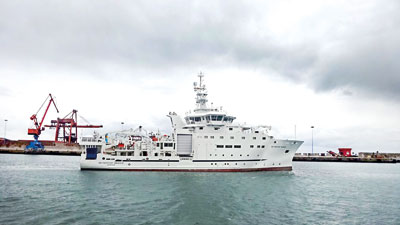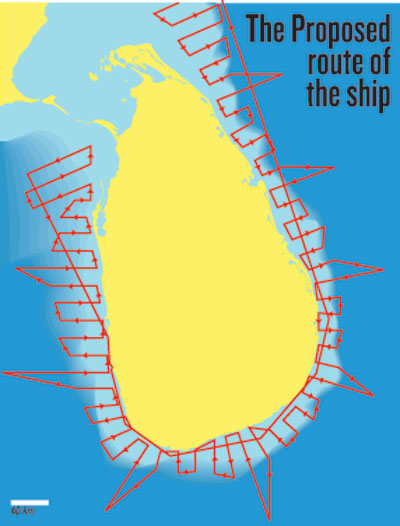News
Norwegian researchers sail in to probe fishing stocks
The long-awaited Norwegian research vessel, RV Dr Fridtjof Nansen, which sails around the globe helping developing countries set up ecosystem-based fishery management, will reach Colombo on June 22.

Sailing around the globe: The Norwegian research vessel, RV Dr Fridtjof Nansen
The Nansen, regarded as the world’s most advanced marine research vessel, will sail around Sri Lanka for 26 days, surveying oceanic conditions and fish stocks.
The ship is named after Norwegian scientist, explorer, diplomat, humanitarian and Nobel Peace Prize laureate Dr. Fridtjof Nansen (1861-1930), who became famous for his North Pole expeditions. The Nansen Research Programme commenced in 1974.
This is the third consecutive research vessel dedicated to surveying marine resources in developing countries. The ships have made the equivalent of 60 voyages around the globe since the programme’s inception.
The first Nansen vessel surveyed Sri Lankan waters in 1978 and 1980. Since then, no such comprehensive survey on Sri Lanka’s marine environment has taken place.
In the last decades, depletion of marine fish stocks has been rampant. A major aim of the Nansen Programme is to help scientists understand the reasons for such depletion and provide data to help to lessen pressure on fishing.
“Most of the data about fisheries are extractions based on catches by fishermen. An independent study is required to assess depleting fisheries stocks and find out new fishing grounds. There can also be under-utilised fish stocks that can be harvested successfully, and research would help us to identify such opportunities,” said National Aquatic Resource Research Development Agency (NARA) Deputy Director-General Dr. Palitha Kithsiri.
While sailing on a pre-defined path around the Sri Lankan coast, the Nansen will lay nets and carry out experimental trawling at various points. The fish and other creatures caught in the nets will be analysed for detailed information on species, sizes, and catch quantity. As well, acoustic methods will be used to estimate the quantity of fish found in those waters.
Sampling will be undertaken on plankton, fish egg and larvae, jellyfish, top predators and marine life in the main oceanic zones: demersal (bottom-feeding fish in deep waters and on the seabed), mesopelagic (fish found in the intermediate ocean layer, 200-1000m deep) and pelagic (fish that swim largely in open water away from the seabed).
The onboard researchers will collect data on water parameters, sea temperature, and salinity, and will map the sea bed using powerful eco-sonars.
“So, in a nutshell, the research will collect data that will help to implement an Ecosystem Approach to Fisheries (EAF), which is more than simply assessing fish stocks,” Dr. Kithsiri said.
The Nansen Programme is executed by the United Nations Food and Agriculture Organisation (FAO) in close collaboration with the Institute of Marine Research (IMR) of Bergen, Norway, and is funded through the Norwegian Agency for Development Cooperation (NORAD).
The Nansen’s 2018 research campaign began in January in Durban and, after taking in Sri Lanka, is expected to end in mid-October in Thailand, FAO program officer Roshini Gunaratne said.
“The overall objective of the programme is to strengthen regional and country-specific efforts to reduce poverty, create optimum conditions for achieving food security and nutrition through the development of sustainable fisheries management systems” Norwegian Ambassador Thorbjorn Gaustadsaether said.
“Norway, as a maritime nation, believes in sustainable development and plays a leading role in battling marine litter,“ the ambassador added. Plastic pollution of the oceans has become a huge problem: plastic and plastic microfibre being ingested by fish is killing them and has the potential to enter the human food chain through the fish we consume.
Global warming will change the dynamics of the ocean but we know very little about such changes. One obvious example of climate change is the coral bleaching caused by ocean warming.
While sea temperature fluctuations disrupt oceanic currents, excess carbon dioxide, believed to be the triggering fact of global warming, could create acidification by dissolving additional carbon dioxide in seawater from the atmosphere.
Fish species are particularly sensitive to these parameters, so it is expected that changes in acid levels in the seas would change fish movement patterns.
Changing temperatures in the seas could make migratory fish such as tuna, sardines and squid could shift their paths of migration and this would affect fishing catches.
Capacity-building is central to all the activities of the Nansen programme. Twenty Sri Lankan scientists active in the fisheries sector will gain the opportunity to be part of the Nansen programme according to NARA’s Dr. Prabath Jayasinghe, who has been nominated the local cruise leader of the Nansen.
A conference on sustainable development goals linked to the oceans will also take place as part of the visit of the Nansen.
| Even fish favourites threatened with extinction | |
| When we visit the market to buy fish from the “malu lella” we seldom think about how these fish that are free-living creatures can face extinction if we continue to catch them without set limits.Some fish, such as sharks, are slow breeders that cannot stand over-fishing. The increasing price of some fish varieties is an indication that they are becoming rarer.Sri Lanka’s favourite fish, the yellow-fin tuna (kelawalla) and seer fish (thora) are categorised as “Near-threatened” on the International Union for the Conservation of Nature’s (IUCN) Red List of Threatened Fauna – only two steps away from the more dire “Endangered” category. Some coral-inhabiting fish such as the hump-head wrasse are “Endangered”, along with elephants and leopards – but fish rarely gain the attention its terrestrial counterparts attract in conservation. The ocean has different zones based on depths and particular fish inhabit each regions. NARA’s Dr. Palitha Kithsiri said the Nansen’s research will focus on studying the mesopelagic (200m-1000m deep) region, which is currently not much targeted in fisheries. |

